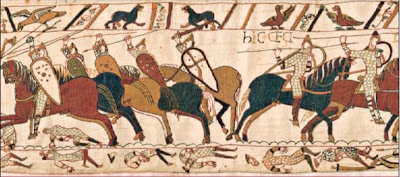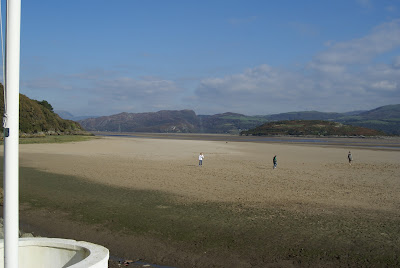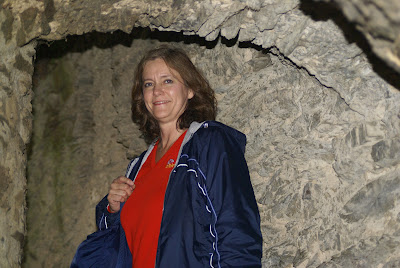It was a very good trip from Harlaxton to France. We took the train from Grantham to London and then took the Tube with about the same number of people that live in Bombay. We only had to go from Kings Cross to Waterloo stations which is just a few stops but includes a change of subway line. We got on to the second line (Bakerloo – as if that means anything to you folks- I will tell you it has nothing to do with the bathroom of the companion of the butcher and the candlestick maker) and it was very crowded. At the next stop no one got off and 337 more people got in our car. At the next stop there were a lot of folks waiting. The doors opened and the folks waiting just looked at the sea of compacted bodies and decided to wait for the next one; that is all but one of them just looked. One “gentleman” with two bags decided he was getting on the subway come Hades or floods. He tried and managed to eventually to get in but not before he had the doors try to close twice on his leg and his suitcase. He and I shared the same personal space for the duration of our ride. Thankfully that was not long. We made it and actually caught a train to Portsmouth about half an hour earlier than our plan. We thought we would be cutting it close to make the ferry. It turns out that we waited 45 minutes or so before they let us board the ferry anyway.
The ferry was large with a whole raft of school groups running around acting like school groups. Evidently it is fairly common for both British and other countries to take their classes on field trips for the day or weekend to another country. One of the visiting faculty members has a 10 year old son (Cameron). His class was taking a trip on Friday to France. Cameron did not get to go because being an American and a non European Union citizen the paperwork was going to be too much hassle.
I stayed up for a while (we left at midnight). I thought I might get some night pictures as we pulled out of Portsmouth. However it is rather difficult to take a time exposure on a moving ship.

We had a nice cabin (small). We both slept some and it was a smooth crossing. The ship wide alarm went off about 5:30 to get everyone up on time. Fortunately it was nice classical music that they woke us up with.
After breakfasting on the ship we made our way with the other foot passengers (evidently all those other people came on board on their hands and knees) to the passport control which is not needed for anyone with an EU passport. We took the bus into Caen.
Caen is a city that was virtually all built since 1945. It was almost all leveled in WWII. The Cathedral in the center of town and two castle structures built by William the Conqueror were largely untouched in the war. Everything else is modern. We decided to take-in the Caen Museum. It was a history of WWI and WWII as well as the cold war. It had a large section dealing with peace.
I was reminded about the human suffering in the war. The people of Russian suffered horribly in the siege of Leningrad. Thousands of people starved or died of disease as a result of their malnourishment after the Germans invaded. The museum did have some information about the final solution and the holocaust. Although I am not sure I saw that word used. It was not a major part of the museum. It was presented but I guess I wanted to see a more prominent role for that part of the story.
There was a startling map of occupied Germany that had marked all of the concentration camps and the work camps that surrounded the main camps. I had never considered how many there were.
There was a very interesting section on the French Resistance and how they operated and how the Germans developed ways to triangulate the radio signals and find the broadcasters. This led to the Resistance finding ways to hide and move their broadcast equipment.
When the information about the cold war was presented it painted America as an exporter of our pop culture which was seen by the Soviets as a bad influence. I found myself very ambivalent as I agreed that much of what the US exported and continues to export is not very wholesome nor very meaningful (they had displays of Hollywood exports and lots of things from the 50s like the music). I could not help but think that the only way we could export that culture was if someone wanted to import that culture. Then I thought, that is the same logic as a drug dealer.
We had a bit of difficulty finding a taxi to take us back to the train station. After about 20 minutes the taxi that was called did show up. The 15 minute train ride from Caen (pronounced like you were trying to rip off an elderly person -CON) to the small town of Bayeux (pronounced like the Louisianan “bayou” but only if you say it like they do in the heart of Cajon country. “by ooooh” not the Houston “by oh”.)
That is enough French lessons (we have exhausted my knowledge). In contrast to Caen, Bayeux was virtually untouched in the battle for Normandy following D-Day. Bayeux was the first town that was liberated by the Allied troupes (two small villages preceded). When the allied troupes arrived the Germans had already pulled out to establish a front north and east of the town. So there was no resistance and thus no real damage to the city. Many of the buildings date from the Middle Ages and the streets are cobblestoned and quite narrow (and filled with very noisy motorcycles).
There is a very large cathedral called Notre Dame but not the one in Paris. The cathedral does have the similar style with the flying buttress that the one in Paris has.
Bayeux is also home to a 1000 year old tapestry that is almost perfectly preserved. I had envisioned a wall sized square rug-like tapestry like I have seen in other castles depicting a scene in the life a king or someone. The Bayeux rendition is a story telling tapestry that was embroidered with wool thread on a linen cloth. The cloth is about 2 feet tall and almost the length of a football field. It tells the story of William the Conqueror. The importance of this “history” is supposedly in the details it provides for the story and the daily life at the time (circa 1066). William became King of England and he was a Norman (French Viking type person – Nor(th)-man).
I am learning in British Studies that this was the beginning of a very long and bitter love hate relationship between the English and the French. The love part, while very powerful and usually short lived, is evidenced in things like D-day when Britain played a major role in the liberation of France. The Americans and the Canadians were trained and staged in Britain. Also the British Navy was largely responsible for clearing the mines out of the channel before the D-day landing. The hate part is evidenced by the 100 years war, and this weekend’s Rugby World Cup match which England won. The tapestry displays a lot of details about the kinds of weapons and clothing that people would have worn. They would not let me take pictures so I was forced to buy these.


The cathedral closed at 6:00 so we thought we would have dinner. We had picked out a restaurant based on recommendations on “tripadvisory.com”. This restaurant was right across from the cathedral but it was closed. We walked to another, it was closed and another, closed. We finally found one that had hours posted in the window and it turns out (which we confirmed) that most of the restaurants are opened from 12 until 2 and then from 7 until 11. We thus went back to the hotel and regrouped until just before 7:00.

We walked back the 8 or so blocks to the cathedral and our restaurant. We arrived at a few minutes past 7:00 and were given a table. The restaurant began to fill up soon after that. A sorority (I assume) arrived about 7:30. There were 25 or so young ladies from America who were having a nice time. The restaurant had an upstairs that could seat at least 25 or 30 and the downstairs where we were had a front room with the sorority ladies and our room with seating for 15 in or so. The room had beamed ceilings with things like old chairs and glassless windows hanging on the wall. The atmosphere was nice.
Not long after the sorority ladies arrived a group of 25 or so guys showed up and walked orderly upstairs. This is how I estimated the size of the upstairs. I had thought they might be there to watch the rugby match but it turns out that was Saturday night. Whatever they were doing they were very quiet about it. The ladies were chatting and by the end of the evening and several bottles of wine they were taking turns getting French kisses (the kind on both cheeks) form the waiter. The entire restaurant was being served by one man and one woman with one assistant. They were hopping. They were very attentive to everyone. They were on a dead run most of the evening.
Our dinners were very nice. We had the three course dinner. I had boiled shrimp (head and all) as an appetizer. Everything was presented like a French cooking show (wait a second…), lots of little garnishes and large plates. The shrimp was served with a small bowl of mayonnaise. I was thinking ketchup would be better until I tried the mayonnaise. I don’t know how it would be with fried shrimp but it is great with boiled. Penny had bacon (ham) and cheese on toast. It was not that common. It was served on a bed of mixed greens and she really enjoyed it. Our main course was the fish of the day. It was grilled cod in a delicious cream sauce with snow peas and beans, rice and a dollop of mashed carrots. For dessert I had ice cream and chocolate sauce with crunchy cookie things. Penny had Crème Brule. The meal was delightful. Ok, Penny says the cooking show is over now.
Saturday
We were taken on an all day tour of the D-day beaches and some of the towns and places of interest. Our guide was named Phillip (fay leap). We found out far more about Phillip than I wanted to know. He was very knowledgeable and seemed to have almost everything about the Battle of Normandy committed to memory (of course he could have told me that Mickey Mouse was the first Marine on shore and I would not be able to disprove it.) As the day wore on Penny and I both came to the conclusion that Phillip’s biggest joy in life was making himself look good at the expense of other people. He was not content in just telling us the information. He had to quiz us (there were two other Americans on the tour) about whether we knew who the American soldier was that led the attack at such and such a battle. He then spent a great deal of time talking about the mistakes that were made in the preparation and execution of the D-day plan. I am sure that the information he provided was correct. For example he said that the calculation of how much gunpowder to use to shoot the grappling hooks to the top of the cliffs was done with figures of the weight of the rope when it was dry. On D-day the rope was wet and thus many of the grappling hooks did not make it to the top of the cliff. The American landing craft only had one motor and not enough power to land easily with the current that was there. He told of the paratroopers who were dropped in the wrong places because of the young scared pilots who failed to recalculate the time in flight when the speed changed.
Phillip had many more of these stories. I wanted to say to him that it all seemed to work out fairly well for France in the end. But I held my tongue.
We were taken to Omaha Beach where so many men lost their lives and also to Utah Beach which was less well defended. This is Utah Beach.
But despite all that attitude, Phillip was very educational. One of the more memorable parts of the day were visiting the towns and farms where various events took place that had pictures taken by journalists and a few soldiers who broke orders and brought cameras. Phillip would park in the town square and show us the pictures and with the same buildings in the background.
We went to some of the remaining German bunkers and saw how solidly they were built to withstand the bombardment. We saw Omaha Beach where so many Allied forces were killed as they tried to land. The defenses on that beach were very difficult to stop. Utah Beach on the other hand was very lightly defended because they had withdrawn for some reason several of the cannons that had been stationed there.
I was reminded of the film we had seen the day before in the Caen museum. The first part of the film had a split screen with the right side showing German film and pictures from Normandy in the days leading up to D-day and the left half showed the allied force preparation. The film demonstrated that people died on both sides of the battlefield.
The American Cemetery that overlooks Utah Beach was a stark reminder of the men who died here.

All of the men buried here died during the Battle for Normandy. But as I looked at marker after marker the day that kept appearing was June 6, 1944.
It was a very moving day.
Saturday evening we walked around and looked at menus and then wound up back at the same restaurant. We were joined by the sorority ladies again only this time they ate upstairs.
Sunday
We have been traveling since we left the hotel at 9:00 and it is now 10:22 and we are still on the train. We walked, took a train, then a bus, then a ferry, a taxi, then a train, then a bus, then a train, then two subways and now a train and we have one more taxi before we get home. Traveling is fun and tiring.
Ray










